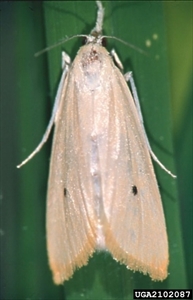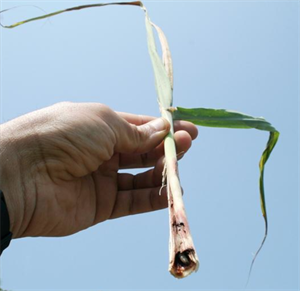- Restricted. South, East and Southeast Asia, North America (Hawaii), Europe, Oceania. In Australia, Papua New Guinea.
- Severe on rice, sorghum, maize, but also on sugarcane, millet, and wild grasses.
- Larvae tunnel through internodes of stem to the growing point, killing it; stems pull out easily (‘deadhearts’). Panicles fail to emergence, or panicles emerge with white unfilled grain (‘whiteheads’).
- Eggs (scale-like) up to 60 in several rows, yellow, laid on leaves. Larvae, yellowish, with five longitudinal purple to brown stripes, brown heads, 25 mm long. Disperse on silk threads. Adult forewings yellowish-brown, dark flecks and marginal black dots; hindwings whitish. Spread on the wing. Nocturnal.
- Natural enemies: many egg and larval parasitoids and predators.
- Biosecurity: introduction possible on produce contaminated with infested stems of host plants.
- Cultural control: plough land well (IMPORTANT to bury larvae/pupae of previous crop); plant at higher density than normal; rotate two crops rice then fallow, or plant maize, soybean or peanut; synchronise plantings with neighbours; submerge eggs by raising water occasionally; weed; apply split applications N; harvest at ground level to remove larvae; plough in stubble, unharvested plants and weeds; use resistant (short, high tillering, early maturing) varieties.
- Chemical control: use abamectin, or tebufenozide to disrupt moulting. Avoid broad-spectrum insecticides to preserve natural enemies.








